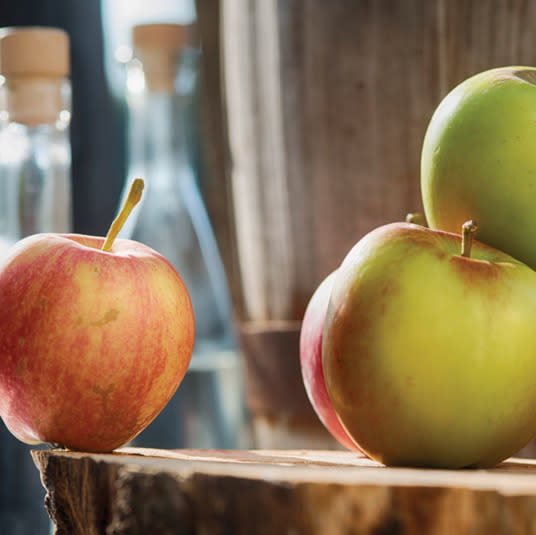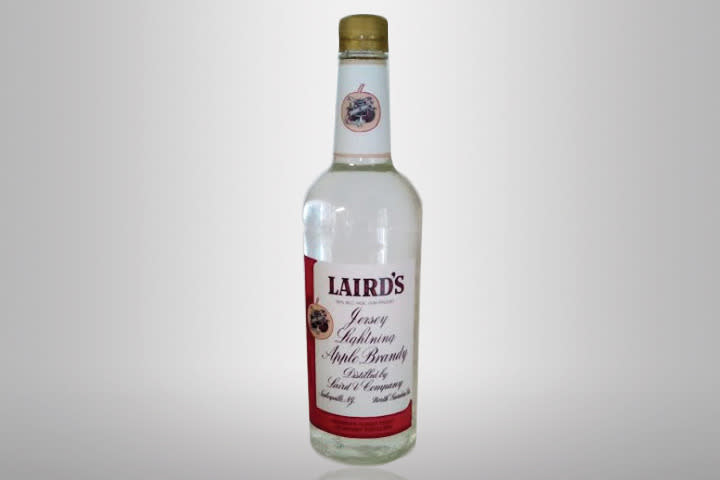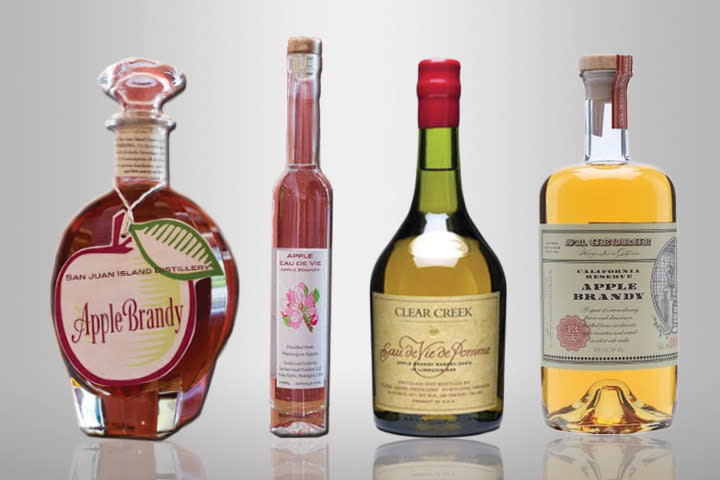Why You Should Be Drinking Apple Brandy and Applejack This Fall

What’s more American than apple pie?
Apple brandy. Beating even bourbon to the punch, the beginnings of American apple brandy stretch back to the 1600s, when colonists were cultivating apple orchards throughout the Northeast and producing hard cider.
But why settle for cider when you could make something stronger? In the name of progress, those resourceful colonists upped cider’s alcohol content by leaving barrels outside overnight to freeze. This clever method, also known as “jacking,” allowed drinkers to separate the alcohol that didn’t freeze from the ice remaining in the barrels, resulting in a high-proof “applejack.”
Cut to 1698, when an important figure named William Laird settled in New Jersey. As a Scotsman, Laird brought with him a knowledge of distilling. The obvious next step after landing in the heart of apple country? Start distilling apple spirits. Laird began producing apple brandy, and, in 1780, his great-grandson Robert established Laird & Company, which is officially the nation’s oldest licensed distillery. By that time, the family’s products were so popular that George Washington himself asked the family for their “cyder spirits” recipe, and records show that he later sold some of his own making.

Nine generations later, the Lairds are still America’s top apple brandy producer. Today, Laird & Company offers a 100-proof Straight Apple Brandy, 7 ½-year-old bottle and the rare 12-year-old. The Straight Apple Brandy is a blend of eight different apples and is aged in bourbon barrels for four years, giving it the heft of whiskey with a pronounced flavor of apple and baking spices. While that and the 7 ½-year-old are naturals for mixing into cocktails like the Old Fashioned, the richly-flavored 12-year-old is best reserved for sipping neat like cognac.
What about ye olde “applejack?” That word is still in use, although its modern meaning is often confused. Before 1968, applejack was synonymous with apple brandy. It was only when consumer preferences started moving towards lighter products that applejack’s distinct identity took shape. With clear spirits like vodka and gin taking the lead, whiskey makers started producing lighter blended products to compete. The Lairds followed suit by working with the government to establish a new federal standard for a blended apple brandy, now known as applejack. The result? Applejack is now defined as a blend of at least 20-percent apple distillate with neutral grain spirit that must be aged four years in used bourbon barrels.
According to the Lairds, they’re still the only ones producing true blended applejack, and their bottle is a richer blend of 35-percent apple brandy and 65-percent neutral grain spirit. Blended applejack tends to have a mellower apple flavor than pure apple brandy, and is now used most famously in the Jack Rose cocktail, a three-ingredient star made with applejack, grenadine and lime juice.

Just when you thought the Lairds had run out of ideas, 2015 brought a new bottling. Because straight American apple brandy isn’t required to conform to origin and aging rules like its French cousin Calvados, American makers can sell both unaged and aged bottlings. Enter Laird’s Jersey Lightning, a clear, unaged apple distillate. After being encouraged by bartenders to start bottling the delicious unaged brandy, Laird & Company finally released this boldly flavored, moonshine-esque liquid that’s a prime candidate for mixing.
What better time to explore the warming depths of apple spirits than mid-fall? Though Laird & Company reigns as the grandfather of American apple brandy as we know it, other local producers have been fiddling in the orchard as well—with exciting results.

Take Black Dirt Distillery in Warwick, New York, which is honoring the region’s historic ties to apple spirits. The Black Dirt region was home to dozens of applejack distilleries prior to Prohibition, and today, the distillery offers a Bonded Apple Jack (that’s 100-percent apple brandy) made from New York–grown Jonagold apples. Also consider Harvest Spirits Distillery, which produces Cornelius Applejack, a smooth, refined apple brandy made from local apples and aged in Woodford Reserve bourbon barrels.
Apple brandy isn’t confined to the Northeast either. Even bourbon country is getting into the apple business thanks to Copper & Kings distillery. In the heart of Louisville, Copper & Kings produces a copper pot–distilled apple brandy that’s matured in Kentucky bourbon barrels and sherry casks. It has an aromatic spirit with hints of sherry and butterscotch.

Live on the West Coast? San Juan Island Distillery makes award-winning Apple Eau de Vie and Apple Brandy off the coast of Washington. With a climate similar to Normandy, the island is ideal for growing apples, and the distillery has adopted French Calvados techniques such as aging in Limousin oak barrels. The Eau de Vie has a clean, fresh apple taste, while the Apple Brandy is a delicious digestif for pairing with desserts and cheese.
Portland-based Clear Creek Distillery also makes an excellent Eau de Vie de Pomme that’s considered a worthy rival of Calvados. Made with Golden Delicious apples from the Yakima Valley, it’s aged in a combination of old and new oak Cognac barrels for eight or more years. The result is a smooth, pale golden spirit that nicely balances the flavor of sweet apples and oaky wood and is easily sipped neat or in cocktails.
California heavy-hitter St. George Spirits released its limited edition Reserve Apple Brandy in 2014. If you’re lucky, you might still find a few bottles of the rare spirit made with a field blend of apples sourced from a single orchard within 150 miles of the distillery. Crafted with the intent of capturing the fruit’s full flavor, the brandy bears bright notes of green apple and caramel with a honey-cinnamon finish that’s perfect in a Hot Toddy.

